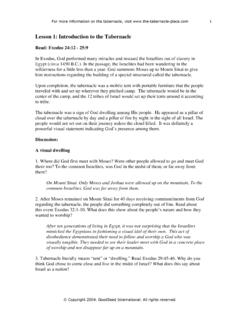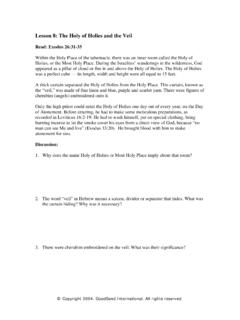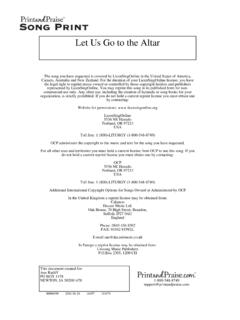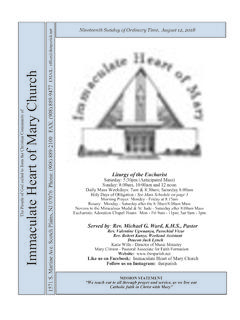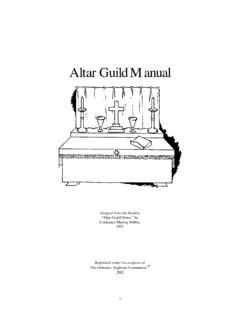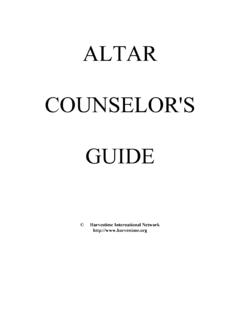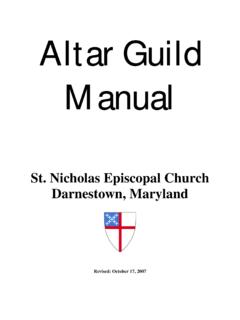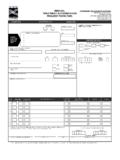Transcription of Lesson 3: The Brazen Altar - GoodSeed
1 Lesson 3: The Brazen Altar Read: Exodus 27:1-8 The Brazen Altar , bronze Altar , or Altar of sacrifice was situated right inside the courtyard upon entering the gate to the tabernacle. The Hebrew root for Altar means to slay or slaughter. The Latin word alta means high. So an Altar is a high place for sacrifice/slaughter. The Brazen Altar in the tabernacle courtyard stood raised on a mound of earth, higher than its surrounding furniture. The Altar was made of wood from the acacia tree and overlaid with bronze (usually symbolic of judgment on sin in the Bible), measuring feet on all four sides and feet deep. Four horns projected from the top four corners and a bronze grating was inside to hold the animal.
2 Discussion: 1. The Brazen Altar was situated very strategically: It was placed in the courtyard right inside the gate, so that it was the first thing one encountered upon entering the tabernacle complex. Why? (This is a review of question 6 in the previous Lesson .) The Altar was the place for burning animal sacrifices. It showed the Israelites that the first step for sinful man to approach a holy God was to admit that he was a sinner. He had to bring an animal sacrifice to offer on the Altar , which showed that he needed to be cleansed of his sins by blood. Similarly, when someone wants to approach God today, the first thing he needs to do is to admit he is a helpless sinner and look to the sacrifice of Jesus on the cross for his sins.
3 The Altar and the cross were both places of death where a sacrifice was made to atone for sin. 2. God laid out various laws for different kinds of animal sacrifices in the book of Leviticus. Read Leviticus 4:3, 23 and 28. What is the significance of bringing an animal without defect? God s holiness demands perfection and sinlessness in His presence. Only a perfect animal was acceptable to God. A defective animal sacrifice could not cover sin because it had an imperfection, which implied uncleanness or sin. 3. Read Leviticus 4:15 and 29. What is the significance of laying hands on the animal before it is slain? By laying his hand upon the head of the offering, the person was identifying with the sacrifice.
4 His sin and guilt was being moved from himself to the animal. He was showing that he believed God would keep His word and forgive his sins because the animal was dying in his place as his substitute. For more information on the tabernacle, visit Copyright 2004. GoodSeed International. All rights Read Leviticus 17:11 and Hebrews 9:22. Atonement means covering for sin, and blood was the agent for atonement in the Old Testament. What was the significance of blood and how could it atone for sins? God s law requires death as the penalty for sin. God said that blood represents the life of a creature. When an animal was slaughtered and its blood shed, its life was poured out.
5 It was dead. This appeased God s wrath because proper judgment for sin had been executed: A death payment had been made. When God saw the death and blood of the innocent sacrifice, He was satisfied that the demands of his law had been carried out. Note that sacrificing an animal on an Altar did not take away the sin. Man was still sinful. The sacrifice only pictured what was necessary for sin to be forgiven death and shedding of blood. The blood provided an atonement, or covering, for sin. (More on this will be addressed in question 6.) 5. Read John 1:29 and 1 Peter 1:18-19. What did John the Baptist and Peter recognize about Jesus so that they would call Jesus a lamb ?
6 Relate this to what we have been studying about the animal sacrifices and the Brazen Altar . John the Baptist recognized that Jesus Christ was God s provision of a perfect sacrifice for the sins of all mankind. He was without sin, just as the sacrificial lamb was without blemish. He was raised up on the cross just like an animal sacrifice was raised up on the Altar . He was killed and his blood was shed on the cross, just like an animal was slaughtered and its blood poured out at the base of the Altar . Just as the guilt of the man presenting the sacrifice was transferred to the animal when he laid his hands upon its head, our guilt is borne by Christ when we put our trust in His death for us on the cross.
7 6. Read Hebrews 10:1-18. How is the sacrifice of Christ fundamentally different from that of the animal sacrifices presented year after year in the Old Testament? When the Israelites offered sacrifices, they had to perform that action repeatedly, year after year. Although God temporarily overlooked the Israelites sins, the blood of the animals did not remove their sins. The sacrifices were a temporary covering that pictured what was necessary for sin to be forgiven death and shedding of blood. The Israelites showed that they believed God s requirements for forgiveness by carrying out the sacrifices each year. Jesus Christ came as the ultimate and last sacrifice for mankind when He offered up His life.
8 We do not need to offer animal sacrifices any more, but instead, we put our faith in Christ s permanent work on the cross. His blood covers our sins past, present and future. When God looks at us, He sees the perfection of His son. It is not like the temporary nature of the animal sacrifices. It is once and for all. For more information on the tabernacle, visit Copyright 2004. GoodSeed International. All rights Horns were a symbol power and strength in biblical times. When the sacrifice was made, blood was dabbed on the horns of the Altar . In light of Christ s sacrifice, what do the horns on the Brazen Altar mean to us as believers? The horns signify the power of blood to atone for sins.
9 There is mighty power in the blood of Christ. Jesus is the horn of our salvation (Psalm 18:2, Luke 1:69). For more information on the tabernacle, visit Copyright 2004. GoodSeed International. All rights reserved.


